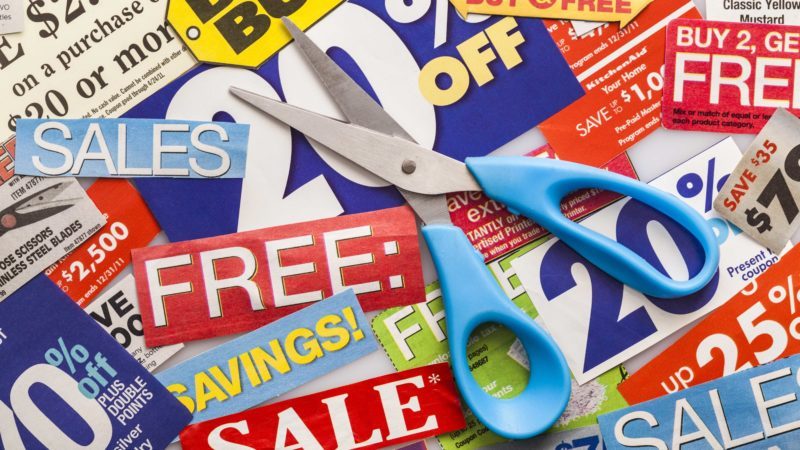
Table of Contents
ToggleIf you don’t use coupons, you’re spending way more than you should. These tips will turn your next shopping trip into a savings extravaganza.
It’s time to ditch your preconceived notions of coupon shoppers: There are savings to be had! In the digital age, how to coupon has changed and is constantly changing. Sure, you can still clip coupons from a printed publication, but you can also be a stealthy saver by loading coupons to your customer-rewards card linked to the stores where you shop. And that’s just one way to get massive savings with very minimal work. We asked two couponing experts who save thousands each year for their best tips, and this intel does not disappoint. So, forget the term crazy coupon lady. If you’re a crafty couponer, you can score huge savings—and keep more of your hard-earned money in the bank.
Keep an eye out for new products
Yes, companies spend a lot of money on advertising and marketing when they’re introducing a new product. But they also know that word-of-mouth recommendations are extremely important to a product’s success. You can use this knowledge to your advantage, says Becky Beach, a self-proclaimed couponing enthusiast and blogger at MomBeach.com who saves around $3,000 each year with her couponing techniques. She suggests reaching out to companies advertising something new on their websites and asking if they’d consider sending you a sample to try. “Most will send me a free product coupon in the mail,” she says. “I then will either redeem the product or sell or trade it on Slick Deals.” If you want to try this, first make sure you know these 13 things deal sites won’t tell you.
Be neighborly
Friendly with the neighbors? Don’t be shy about talking up your coupon habit. They may still have a newspaper subscription and be willing to offer up the coupons from the Sunday paper. Or if you know a particular paper is chock-full of great coupons one week, buy extra copies yourself. “I will then match the coupons up with grocery store circulars that I receive in the mail and subscribe to online,” says Beach. “Coupons.com is a great site to print out coupons as well, and you can then match those up with circulars, too.” This is a good idea because the circulars will tell you which items are already on sale for the week. Then you can look at the coupons in your stash and see if you can get any additional savings. Using a coupon on an item that’s already on sale delivers the biggest savings.
Get creative
When learning how to coupon, find ways to double up that are “legal.” Mary Potter Kenyon, author of Coupon Crazy: The Science, Savings, and Stories Behind America’s Extreme Obsession, recommends using a store coupon and a manufacturer’s coupon on the same item for big savings. “Store coupons are essentially special ‘sales’ offered,” she explains. “They are good in that store only. But you can use a manufacturer coupon on top of the store coupon on the same product. Manufacturer coupons are labeled as such. Store coupons will usually have the store logo on them.” When in doubt, ask a store manager if they will honor the coupons together. No matter where you shop, these 50 insider secrets will help you save at all your favorite stores.
Proceed with caution
Just because you have a coupon, you don’t actually need to use it. When is this particularly true? When the deal isn’t that great. “You aren’t saving money if you purchase a pricey product just because you have a coupon for it if you can find a similar and cheaper store-brand version,” says Kenyon. You should also resist the temptation to use a coupon when you don’t really need or want a product. “You will always find coupons for unhealthy frozen food products like pizza rolls and cold cereals, but sometimes it’s worth the extra money and time to make your own pizza rolls or cook up a pot of oatmeal,” explains Kenyon. “In other words, just because you have a coupon, it doesn’t mean you should buy the product.”
Be a trader
Kids trade Pokémon cards they have doubles of or aren’t particularly interested in, and you can apply the same strategy to couponing. Beach notes that it’s easier than ever to trade (even sell) coupons your household doesn’t need. “I go to the Slick Deals coupon forum,” she says. “See how many people are selling and trading coupons? Coupons don’t have a monetary value, but they are still valuable. There are people in other areas of the United States who don’t get the same coupons as you, so will gladly pay or trade for them.” The digital world is always changing, so you need to stay apprised of its latest tricks. Here are some other genius ways to save big online.
Always check to see whether a store accepts coupons
Stores that already offer items at steep discounts may appear to be off-limits for coupon use, but that isn’t necessarily the case. Kenyon, who teaches workshops on how to coupon at community colleges and libraries, points out that Dollar Tree now accepts coupons. “Since everything is $1 at Dollar Tree stores, you can get some amazing savings,” she says. “You never know what you’ll find at the Dollar Tree, but I’ve used many 50-cent coupons on toothpaste there, knocking the price down to 50 cents. I’ve even found Covergirl products that I can use my $1 Covergirl coupons on.”
Check store aisles for coupons
Occasionally, customers may find a coupon dispenser in grocery-store aisles. They usually offer a deal on a new product or even an old favorite with a new-and-improved formula. Keep your eyes peeled for these in case it’s an item on your list. Additionally, look for coupons on product packaging. But be a good member of the couponing community: Don’t peel coupons of packages you don’t intend to purchase. Check out these 13 savvy shopping tricks you’ll wish you knew all along.
Peruse clearance shelves
Just as a department store might have clearance racks, grocery stores have shelves of clearance items. They’re often located off to the side or in a customer-accessible hallway. And, yes, you can use your coupons on those previously reduced products. To make sure the transaction goes smoothly at checkout, Kenyon has some advice. “Perhaps the UPC code is blacked out [on the product] and the checker has to hand-key the price into the register,” she says. “Guess what? Your coupon for that product isn’t going to scan either, because the product wasn’t scanned. She (or he) will have to hand-key the coupon into the system as well. Usually, you can explain this and there will be no problem. Occasionally, the cashier will insist that you ‘already got a good deal’ and you can’t use coupons.” If this happens, politely ask to speak to a manager. If the manager responds with the same answer, Kenyon says it’s best to move on because every store has the right to limit coupon use in their place of business. Learning how to coupon also involves learning good etiquette, especially if you want to shop at that store in the future.
Plan ahead
As is the case with most things in life, couponing works best if you’re organized. Keep coupons filed in something easily portable so that you have them nearby before heading into a brick-and-mortar store or restaurant. Kenyon suggests doing the same for online shopping. “Whether it is for free shipping or 20 percent savings at the checkout, there are plentiful coupons available,” she says. “I also go through Ebates (now Rakuten) with online shopping and get a check four times a year.”
Be mindful of restrictions
No one likes surly customers. Understand that those little pieces of paper or digital downloads do come with some rules. Plus, the landscape is constantly changing. “It’s a whole new world for couponers, and not nearly as much fun as it used to be,” says Kenyon, who notes that companies have put more restrictions on coupon use since the dawn of TV shows like TLC’s Extreme Couponing. “That doesn’t mean consumers can’t still save money with coupons—it just means they have to get more creative and pay attention to sales.” Next, check out these 50 ways to get great deals on anything.
[“source=rd”]
Related Post
| M | T | W | T | F | S | S |
|---|---|---|---|---|---|---|
| 1 | 2 | 3 | 4 | 5 | 6 | 7 |
| 8 | 9 | 10 | 11 | 12 | 13 | 14 |
| 15 | 16 | 17 | 18 | 19 | 20 | 21 |
| 22 | 23 | 24 | 25 | 26 | 27 | 28 |
| 29 | 30 | |||||
























